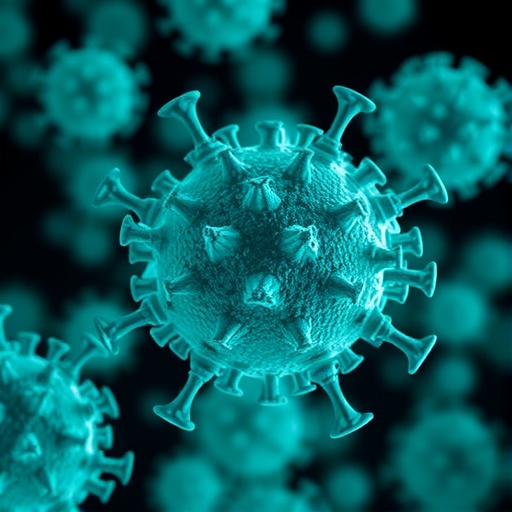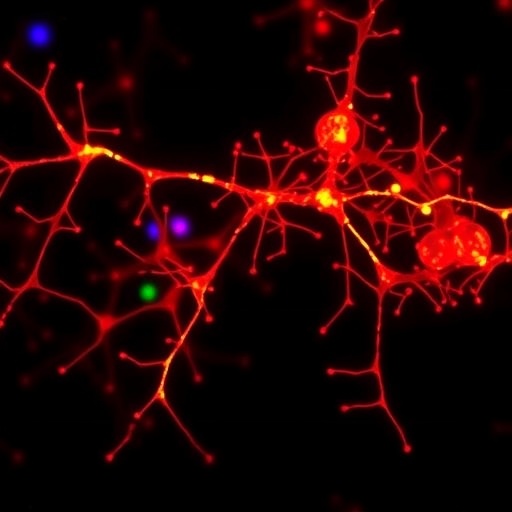In the ongoing battle against COVID-19, the scientific community has made extraordinary strides in developing therapeutic and preventive measures to curb the spread of SARS-CoV-2. One of the most promising strategies has been the use of monoclonal antibodies (mAbs) for pre-exposure prophylaxis, especially for vulnerable populations who might not mount a sufficient response to vaccines. However, the relentless evolution of the virus, spawning numerous variants with varying degrees of immune escape, has challenged the effectiveness of these monoclonal antibodies. In a pioneering study published recently in Nature Communications, Edge et al. introduce a novel model that adjusts the threshold of protection conferred by monoclonal antibodies according to emerging SARS-CoV-2 variants, offering a cutting-edge approach to optimize prophylactic interventions.
At the heart of this breakthrough lies an intricate understanding of how viral mutations modify the interaction landscape between monoclonal antibodies and the spike protein of SARS-CoV-2. The study addresses a critical gap: while monoclonal antibodies were initially developed and assessed based on prototype strains, the natural evolutionary trajectory of the virus has rendered some of them less effective. This variation in neutralization potency necessitates recalibrating the protective thresholds rather than relying on static benchmarks based on preexisting strains.
The authors embarked on a rigorous analytical journey to quantify the variant-adjusted threshold of protection. By integrating longitudinal clinical and virological data with in vitro neutralization assays, they constructed a mathematical model that maps out the correlation between antibody concentration, neutralization capacity, and resultant clinical protection. This framework incorporates the unique escape characteristics of prevalent variants, including the challenged Omicron sublineages and any emergent strains that exhibit altered susceptibility profiles.
One of the revolutionary aspects of this study is its dynamic approach to monoclonal antibody prophylaxis. Traditionally, dosing regimens were standardized based on the initial efficacy observed during early clinical trials. However, the model proposed here suggests that dosing must be adaptive, factoring in variant-specific reductions in neutralizing capability. Such a concept fundamentally changes the landscape for personalized and population-level prophylaxis, where antibody administration can be fine-tuned to curtail predefined thresholds of viral escape.
Technically, the model applies a Bayesian inference framework to estimate the posterior distribution of protective antibody levels, leveraging real-world effectiveness data alongside neutralization fold changes against different variants. This approach enables the generation of probabilistic predictions about protection efficacy in diverse epidemiological contexts. The study’s computational pipeline was validated against observed breakthrough infection rates in cohorts receiving monoclonal antibody treatment, showcasing remarkable predictive accuracy.
Crucially, the authors emphasize that their threshold of protection model extends beyond immediate clinical utility to inform the future design of monoclonal antibodies. By mapping susceptibility landscapes, researchers and pharmaceutical developers can identify epitopes less prone to mutational escape, guiding the rational engineering of antibodies with sustained potency across variant waves. This preemptive strategy could dramatically improve pandemic preparedness against SARS-CoV-2 and potentially other mutagenic viral pathogens.
Moreover, the research contributes to the broader discourse on correlates of protection in infectious diseases. Defining quantitative immune correlates—biomarkers that reliably predict the degree of protection—is a fundamental challenge. This model exemplifies how integrating immunological parameters with variant-specific virological adaptations can yield actionable correlates that evolve in tandem with pathogen evolution.
Another compelling dimension discussed in the study concerns vulnerable populations, such as immunocompromised individuals and the elderly, for whom vaccine-induced immunity is often suboptimal. Monoclonal antibody prophylaxis can bridge this immunity gap, but variant-induced shifts in protection thresholds have made it challenging to maintain consistent clinical benefits. By using the variant-adjusted model, clinicians can tailor monoclonal antibody regimens to these groups with higher precision, optimizing protection while minimizing unnecessary exposures and resource utilization.
Additionally, the implications of this model reach into global health equity. As variants emerge with region-specific patterns, deploying monoclonal antibodies at scale demands an adaptable strategy that aligns with the local virological landscape. The model’s capacity to incorporate variant prevalence data makes it an indispensable tool to strategize equitable distribution and administration of mAbs in diverse settings, including low- and middle-income countries grappling with variant surges.
The methodological rigor of the study is underscored by its multidisciplinary approach, combining virology, immunology, clinical epidemiology, and advanced bioinformatics. High-throughput neutralization assays provided the raw data for variant escape profiling, while extensive patient-level protection data allowed for sophisticated correlation analyses. The study exemplifies how cross-collaboration across scientific domains can accelerate innovation in response to fast-moving viral challenges.
It is also worth noting the practical applications of this model in regulatory and policy-making arenas. As monoclonal antibody therapeutics pipeline continues to evolve, regulatory agencies require robust frameworks to evaluate efficacy against rapidly changing viral targets. The threshold of protection model offers an evidence-based platform to revise authorization criteria dynamically, enhancing flexibility and responsiveness in public health guidance.
Furthermore, the study addresses one of the pressing concerns in clinical deployment: resistance monitoring. By integrating surveillance data on mutations conferring monoclonal antibody resistance, the model provides an early warning system that could trigger modifications in prophylactic strategies before clinical failures become widespread. This proactive stance is essential in maintaining the clinical utility of monoclonal antibodies and mitigating potential healthcare burdens.
Another notable finding from Edge et al.’s work is the demonstration that even minor reductions in neutralizing potency against certain variants can significantly alter the effective threshold required for protection. This nonlinear impact underscores the importance of meticulous monitoring of viral evolution and rapid adjustment of clinical practices. The model’s sensitivity analysis reveals complex interactions between antibody titers and viral escape mutations, highlighting the delicate balance that underpins successful prophylaxis.
In conclusion, the variant-adjusted threshold of protection model is a landmark advancement in our ability to deploy monoclonal antibodies against COVID-19 effectively. Its adaptive, data-driven nature embodies the evolving scientific ethos needed to keep pace with a mutating virus. By enabling precise calibration of protective antibody levels across different viral variants, it empowers clinicians, researchers, and policymakers to optimize pre-exposure prophylaxis strategies with unprecedented sophistication.
As the SARS-CoV-2 pandemic continues to unfold, innovations such as this model will be vital to sustain therapeutic relevance and public health impact. The fusion of immunological insight, epidemiological data, and mathematical modeling showcased in this research offers a blueprint for tackling not only COVID-19 but also future pandemics shaped by rapid antigenic drift and shift. This study represents a major leap forward in our ongoing quest to outsmart one of humanity’s most formidable viral adversaries.
Subject of Research:
Article Title:
Article References:
Edge, R., Matthews, S., Ahani, B. et al. A SARS-CoV-2 variant‑adjusted threshold of protection model for monoclonal antibody pre-exposure prophylaxis against COVID-19.
Nat Commun 16, 9101 (2025). https://doi.org/10.1038/s41467-025-63972-4
Image Credits: AI Generated
Tags: COVID-19 antibody protectioncutting-edge COVID-19 researchmonoclonal antibodies for preventionNature Communications study on COVID-19novel threshold model for antibodiesoptimizing monoclonal antibody efficacypandemic response strategiesrecalibrating antibody protection thresholdsSARS-CoV-2 variants and immune escapetherapeutic strategies for COVID-19vaccine response in vulnerable populationsviral mutation impact on antibodies






